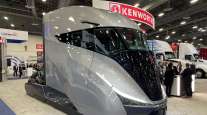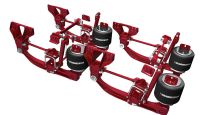Staff Reporter
SuperTruck II Innovations Could Help With Emissions Targets
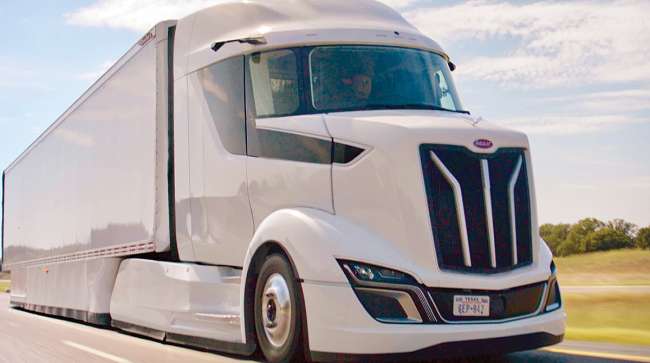
[Stay on top of transportation news: Get TTNews in your inbox.]
LAS VEGAS — Aerodynamic innovations developed for the Peterbilt SuperTruck II concept truck could enter service sooner rather than later to help the company’s trucks comply with forthcoming emissions regulations, according to Paccar executives.
Peterbilt displayed the truck at CES 2024, one of the world’s foremost trade shows for new technology.
“The Peterbilt SuperTruck II demonstrates the art of the possible,” Paccar Senior Director of Global Powertrain Planning and Agency Carl Hergart told reporters at CES. “A lot of these technologies can be applied to any truck.”
“Technologies get introduced when you know they’re ready and you know they provide a solid payback for our customers, that’s what really drives timing,” added Peterbilt Chief Engineer Scott Newhouse.

Aerodynamic improvements are set to become increasingly important with forthcoming Phase III Environmental Protection Agency carbon dioxide regulations, said Hergart. The regulations, announced in April 2023, will apply to heavy-duty vocational vehicles and tractors beginning in model year 2027.
“More customers will have to use aerodynamic improvements,” Hergart said, noting that aero gains will benefit carriers’ fuel efficiency. Still, he noted that the Phase III targets can only be achieved by “an aggressive rollout of zero-emission vehicles.” Paccar also showcased a Kenworth T680 hydrogen fuel cell electric truck at CES.
SuperTruck II’s shape improved aerodynamics by 25% compared with SuperTruck I.
In addition, the tractor cab can drop 4 inches at highway speeds using an automatic chassis lowering system. Paccar also wants the aerodynamic gap between the tractor and trailer to be as small as possible, Hergart said.
“All these technologies, we put them on SuperTrucks and developed them for the SuperTruck programs, so that we can truly evaluate the new lineup developments,” added Newhouse. “If you think about what we might apply, there are some very innovative aerodynamic devices to help with [progress].”
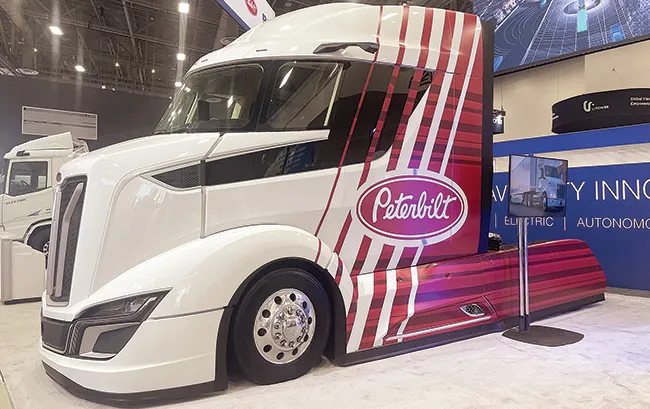
Peterbilt showcased the SuperTruck II at CES. (Peterbilt)
He pointed specifically to extenders attached to the back of a sleeper cab.
“[The extenders are] a system that utilizes the measurements of the wind around the vehicle. Based on that, it adjusts and redirects the air on the trailer, which then ultimately improves fuel economy by not letting the air get trapped between the tractor and the trailer,” said Newhouse. “It is something very innovative that is not used on any other vehicle today.”
In addition, the rear wall of the cab was shifted 5 degrees to cut the gap between the tractor and trailer.
There are two engine alternatives in Paccar’s SuperTruck II program: the in-house developed Paccar MX engine platform and a Cummins powertrain. The Peterbilt truck powertrain is a Cummins 15-liter diesel engine with a 48-volt hybrid system that generates electricity for auxiliary functions and reduces engine requirements. An integrated waste-heat recovery system also helps the engine retain more energy for propulsion. A Kenworth team used an MX engine for its own SuperTruck II.
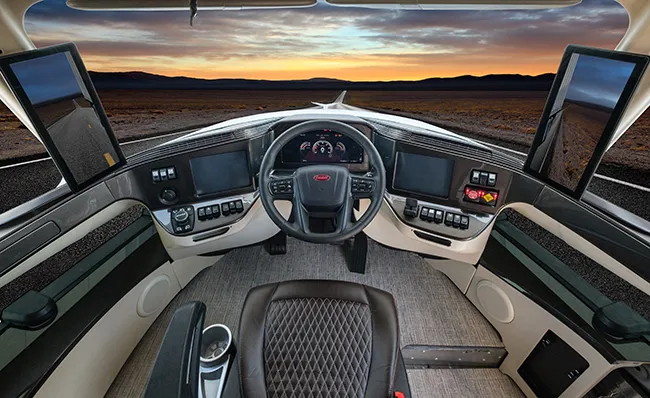
The interior of the Peterbilt SuperTruck II. (Thomas Judd Photo)
Great Dane created a special 53-foot trailer to pair with the Peterbilt tractor. The concept trailer is outfitted with 15 solar panels covering the roof along with weight savings and carbon fiber aerodynamic devices. In total, the combination vehicle is 4,800 pounds lighter than a comparable tractor-trailer.
Peterbilt’s SuperTruck II was first unveiled at American Trucking Associations’ Management Conference & Exhibition in October 2022.
The Department of Energy SuperTruck initiative, launched in 2016, challenged participating truck manufacturers to demonstrate 100% improvement in freight efficiency through next-level technologies that might potentially appear on future production vehicles. Other original equipment manufacturers have developed their own SuperTruck concept vehicles.
Want more news? Listen to today's daily briefing above or go here for more info
Newhouse noted that some of the innovations Peterbilt has developed through the program have found their way onto production vehicles.
“There are some technologies that we have already brought on,” he said. “The low-rolling-resistance tires, the 48-volt generator ... we are applying that type of technology for emissions first, and then we will apply it to other things.”
A third phase of the SuperTruck program will focus on electrified truck technologies. Paccar plans to combine its Peterbilt and Kenworth teams for the next phase.


